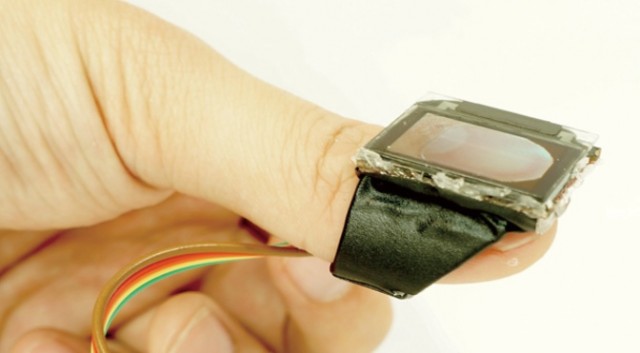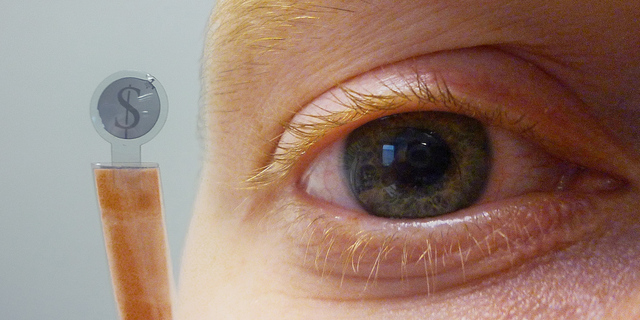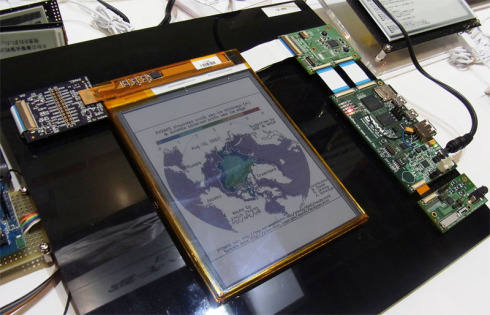
Image via Jinha Lee / NBC News
3-D computing prototype puts your hands inside the screen "Attendees of the latest TED conference got a look at a futuristic device called SpaceTop where the user views a 3-D workspace through a transparent display, manipulating the on-screen elements with just their hands. It won't be on shelves any time soon, but it does pique the imagination. ...The transparent display is equipped with a camera that tracks the user's head and adjusts the perspective on the 3-D desktop "under" it. Meanwhile, a second camera watches the user's hands and determines their position in three dimensions." via NBC News
Sharp Samsung Alliance – An Alliance of Mutual Benefits "Given that Sharp is a leader in oxide TFT technology, especially at Gen 8, it’s possible that Samsung can utilize the oxide TFT backplanes from Sharp for its AMOLED TV." via DisplaySearch Blog
Samsung's investment in Sharp could prick Apple "Apple is believed to buy about a third of its LCD panels from Sharp, and it closely relies on the company for some of its most advanced products, according to analysts. When Sharp has problems, it can slow down the release of Apple devices. So if Sharp starts to favor Apple's chief rival, Samsung, that could have big implications for Apple." via CNET
LG Display Overtakes Samsung in Global LCD Market ""LG Display has found new customers such as Sony and Panasonic and increased production accordingly," analyst So Hyun-chul of Shinhan Investment Corp. said. "It has gained a foothold for growth by supplying most LCD products for Apple's iPads in the explosively growing tablet PC market." In contrast, Samsung failed to increase sales dramatically because it is highly dependent on a single customer, affiliate Samsung Electronics." via The Chosunilbo
Display database for engineers Search thousands of display panels by multiple characteristics and compare results side-by-side using the display database multisearch.
Air Force takes first step in replacing obsolete CRT displays in F-15E jet fighter-bomber "The project calls for eliminating obsolescent or otherwise-troublesome technology in the MPD such as CRT avionics display technology and high-voltage components. The replacement display must not affect the present MPD interaction with the Boeing advanced display core processor (ADCP) or change the operational flight program, Air Force officials say. ...The sources-sought notice is a market survey to identify suppliers with the necessary expertise, capabilities, and experience to develop a replacement MPD for the F-15E." via Military & Aerospace Electronics
5 Tech Stocks That Could Leap On Touchscreen Trends "Sollensys manufactures multi-touch sensor modules for use in the government, education, medical and consumer technology sectors. The company’s goal is to be the leading global provider of small to medium sized capacity touch sensors to the high quality and advanced technology spectrum of the touchscreen market. Through consultation with customers, Sollensys designs, develops and delivers the best possible touch sensor technology for its products. Much like Apple, Sollensys provides a high quality product through excellence in design, advanced process and production techniques, and quality control. Sollensys aims to be a leader in the capacitive touch industry, which is the company’s core technology." via Investment Underground
Flexible, transparent imaging device developed "The new imager, which resembles a flexible plastic film, uses fluorescent particles to capture incoming light and channel a portion of it to an array of sensors framing the sheet. With no electronics or internal components, the imager's elegant design makes it ideal for a new breed of imaging technologies, including user interface devices that can respond not to a touch, but merely to a simple gesture, the journal Optics Express reports. ...The main application the researchers envision for this new technology is in touch-free, transparent user interfaces that could seamlessly overlay a TV or other display technology, according to a [Johannes Kepler University Linz] statement. " via Zeenews
Wearable display meets blindfold test for sensing danger "Researchers at the University of Illinois in Chicago have developed a special set of body modules that provide wearers with extra-sensory perception as to who or what is nearby. The design could help the blind navigate safely or even support cyclists or drivers as additional safety support in traffic. Called SpiderSense, this is a wearable display that can pick up ultrasonic reflections from objects. SpiderSense can also allow the wearer, even if eyes are closed, to navigate." via Phys.org
Beyond a Human Framework of International Relations "Diplomats could soon be wearing AR contact lenses or glasses that will translate in real-time a native’s foreign language, presenting the information like movie subtitles on the lens or glass in that diplomat’s own native tongue. They will be able to translate a newspaper in another language with a glance, access data on treaties and current news events while undergoing diplomatic negotiations, or even assess the disposition of a foreign contact by using lie detection sensors and emotional cues—all displayed immediately through the AR lens interface. The technology has already been used by U.S. Marine mechanics to help them with more efficient repairs. Detailed specifications, for instance, can instantaneously be displayed through goggles when looking over an engine. Other branches of armed forces continue to use and develop new adaptations." via Diplomatic Courier
Swedish university invests in virtual medical display technology "The Sectra Visualization Table is a large, multi-touch medical display with software that facilitates interaction with 3D images of the human body created by modern computer tomography or magnetic resonance cameras. Students are able to intuitively zoom in, rotate or cut into the visualized body without using a scalpel or destroying the subject. This means that the same image can be used repeatedly, and the students are able to study the impact of various illnesses on the anatomy in a manner that was not possible in teaching in the past." via European Hospital
Why E Ink is still the leader in e-paper "Overall, E Ink electrophoretic displays win on production cost. Unlike Liquavista and Mirasol, E Ink displays are compatible with roll-to-roll manufacturing using printing technologies. This has allowed the company to rapidly scale up and produce the electrophoretic material at high volume and high yield, thus offering the product at the right price point for the e-reader market. As of today, Liquavista is still not commercialized despite the fact the technology has been in development for roughly the same amount of time as E Ink's. Mirasol e-readers were sold in East Asia but did not attract enough traction, most likely because the devices were too expensive. " via Printed Electronics World
Do you have content to share with Display Alliance? Anyone can post press releases, white papers, commentary, videos, and more in the open section.
Thoughts on AMOLED and LCD displays in 2013: Is there a clear winner? "In smartphone displays, LCD displays offer a few key advantages over AMOLED displays. Due to the "direct sunlight argument" where the Sun distorts colors and the image projected on AMOLED screens, LCD displays hold a clear advantage. At full brightness, LCD displays get much brighter than their AMOLED counterparts and also use less power in the process. They are miles ahead of AMOLED displays outside, and I'd say this is nearly an undenaible truth, and not an opinion. It's important to mention that LCD displays are only more efficient at full brightness as compared to AMOLED. AMOLED screens are more efficient all around, just not when the brightness is cranked up." via phonedog
LED-backlit display penetration rate to break 90% "LEDinside noted that there are price differences between the side-lighting mode and the bottom-lighting mode of the LED-backlit display technology. The cost of side-lighting mode is 1.5 times that of the bottom-lighting mode as the manufacturing process of the former is more complicated and calls for more expensive parts and components, it said. More than 70 percent of the TV products of South Korea's Samsung Electronics Co. and LG Corp. use the cheaper bottom-lighting mode, while Taiwan's AU Optronics and" via Focus Taiwan
Are you an engineer or have display expertise? Email jason@displayalliance.com to be featured in the interviews section.
A Different Concept on the Future of Helicopter Avionics "“We’ve decided that touchscreens are not the way to go, for reasons of durability and practicality,” said Grady Dees, director of technical sales for Universal Avionics Systems. MD Helicopters vice president of engineering Chris Nehls heartily agreed. “The on-cyclic cursor control keeps the pilot focused on flying, we think,” said Nehls. The engineers decided, as well, to retain certain key knobs that pilots rely on, including the heading bug knob on the panel under the PFD. “It is what pilots are used to, and we want to make the system easy to transition to,” he continued. There is also a separate EFIS control display unit located on the center console that houses all of the buttons and knobs that are conspicuously missing from the bezel of the 12-inch PFD/MFD displays." via AINonline
A Comparison of AU Optronics, LG Display and Sollensys "To sum up, AU Optronics and LG Display have demonstrated poor profitability in the last few years. However, in a fast-growing market as the touch screen panels, a quick turnaround is possible, which may reward their shareholders. It is well known that turnarounds of companies are the most rewarding situations in the stock market. According to analysts' estimates, a turnaround for LG Display is likely in 2013. Sollensys is a nascent company with high expertise and valuable patents. It is promising fast growth, but one should carefully evaluate the audited financial statements of the company when they become available, just as one should do with any investment." via Smallcap Network
Sapphire is unscratchable, unbreakable, and the next big thing in touchscreens "GT Advanced demonstrations were compelling, and the science seems to back it up. Sapphire is a naturally growing crystal and is the second hardest substance on earth. It’s so hard, only diamond-tipped saws can cut it. GT Advanced grows sapphire and then melts and hardens them into ‘boules,’ which are 115 kilogram, or 254 lb. clear cylinders. Those cylinders are then cut into cubes, which are then chopped up into slices and shapes as thin and wild as you can imagine." via Digital Trends
Mobile displays that change shape "GHOSTs are display surfaces made of malleable materials that can change into and retain arbitrary shapes so as to display output from the system or allow new actions. At the same time, GHOSTs enable users to deform, touch, or otherwise manipulate the shape of their display surface to provide input to the system. The collaborative European research project includes Sriram Subramanian, Professor of Human-Computer Interaction in the Department of Computer Science at the University of Bristol, and will bring together a range of partners from across Europe to design, develop and evaluate prototypes to define the current and future challenges of making organic user experiences." via EET India
Digital signage leading the way to a future 'Day Made of Glass' "More vivid, powerful glass substrates extend the scalability, usability and immersiveness of displays and blurs the physical and the virtual, he said. And new glass advances will create form-factor freedom that can drive application diversity and new user interfaces, making them even more intuitive and collaborative — "but we've still got far to go," he said. "Modern displays are still bricks and boxes," he said, referring to the form factors of smartphones/tablets and display screens. And because of this, the relationship between people and devices is backward, with people's environments and users' lifestyles dictated by the limitations of the device form factor, he said. People set up their living rooms to fit their TVs, and not the other way around, he said." via Digital Signage Today
What did you think about today's news? Leave a comment here and share your thoughts.

 News Roundup tagged
News Roundup tagged  E Ink,
E Ink,  LCD,
LCD,  LG Display,
LG Display,  Mattrix Technologies,
Mattrix Technologies,  OLED,
OLED,  OLET,
OLET,  Samsung,
Samsung,  TCL CSOT,
TCL CSOT,  Tianma,
Tianma,  Winstar,
Winstar,  ePaper
ePaper 








